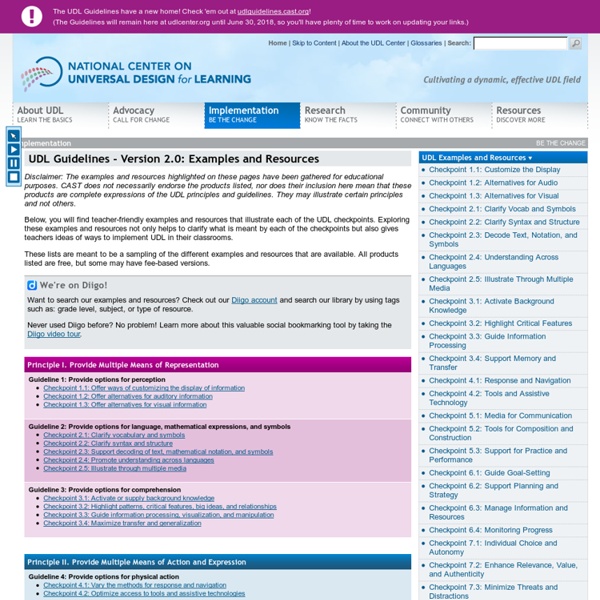Quality Rubrics / Home
Introduction: A search for "rubrics" in Google returns over 2 million results while Amazon.com claims over 30,000 educational books that address them in one shape or another. For any educator looking to know more about rubrics and how to use them in his or her classroom, finding a starting point can be challenging and difficult. This wiki was created as a place to address two needs: First, to explore what makes a rubric a "quality rubric" with definitions, examples, and non-examples. Second, to wrestle with some of the issues that come along with them.
Getting from Here to There
Getting from Here to ThereUDL, Global Positioning Systems, andLessons for Improving Education David H. Rose, Ed. D., and Jenna W. Gravel, Ed.
Search lessons by keyword
Jeopardy [SMART Notebook lesson] A jeopardy game template to be used for a chapter review, or end of year testing review. It takes a while to g... Subject: Special Education, Mathematics, Other, Social Studies, English Language Arts, Science, Health and Physical Education, Art and Design, Citizenship, Modern Foreign Languages, Geography, History, Cross-curricular, ICT, English as a Second Language, Music Grade: Pre-Kindergarten, Kindergarten, Grade 1, Grade 2, Grade 3, Grade 4, Grade 5, Grade 6, Grade 7, Grade 8, Grade 9, Grade 10, Grade 11, Grade 12, Post-Secondary
UDL Toolkits: Teaching Every Student
This toolkit was made possible by the generous support of the Arthur Vining Davis Foundations, the Jessie B. Cox Charitable Trust, and the Fund for Nonprofit Partnerships in the Boston Public Schools. What is the PAL Toolkit? Planning for All Learners (PAL) applies UDL to planning and developing curricula in ways that promote access, participation, and progress in the general education curriculum for all learners. The PAL Toolkit provides specific planning steps, guidance, mentoring, model lessons, tools, templates, resources, and links to other educators using the PAL Model.
Genres...Narrative & Memoir
Our Narrative Workshop's Focus Trait: Idea Development Our Narrative Workshop's Support Traits: Word Choice and Voice In our NNWP workshops, our Northern Nevada participants receive a complimentary copy of the NNWP's print publication, The Going Deep with 6 Trait Language Guide. This 198-page resource is valued tool in Northern Nevada.
ARKive - Discover the world's most endangered species
Wildscreen's Arkive project was launched in 2003 and grew to become the world's biggest encyclopaedia of life on Earth. With the help of over 7,000 of the world’s best wildlife filmmakers and photographers, conservationists and scientists, Arkive.org featured multi-media fact-files for more than 16,000 endangered species. Freely accessible to everyone, over half a million people every month, from over 200 countries, used Arkive to learn and discover the wonders of the natural world. Since 2013 Wildscreen was unable to raise sufficient funds from trusts, foundations, corporates and individual donors to support the year-round costs of keeping Arkive online. Therefore, the charity had been using its reserves to keep the project online and was unable to fund any dedicated staff to maintain Arkive, let alone future-proof it, for over half a decade. Despite appeals for support, just 85 of our 5.6 million users in 2018 made a donation.
UDL Toolkits: Teaching Every Student
d Model of the Internet Inquiry Process This toolkit was made possible by a grant funded by the U.S. Department of Education, Office of Special Education Programs, Grant Award #H324N010005.
UDL Goal Setter: Tools & Activities: Teaching Every Student
The key to helping all students achieve is identifying and removing barriers from our teaching methods and curriculum materials. One effective way to do this is to expand your teaching toolbox with digital media and software. To accommodate a broad spectrum of learners, universally designed curricula require a range of options for accessing, using, and engaging with learning materials. The materials themselves, as well as the teaching approaches, need to be sufficiently flexible to support varied pathways towards common learning goals. Building digital content and tools into your curriculum can help you provide the necessary flexibility to reach diverse learners. The UDL Solutions Finder Tutorial gives you practice in applying CAST's three UDL principles to expand learning options for students.



